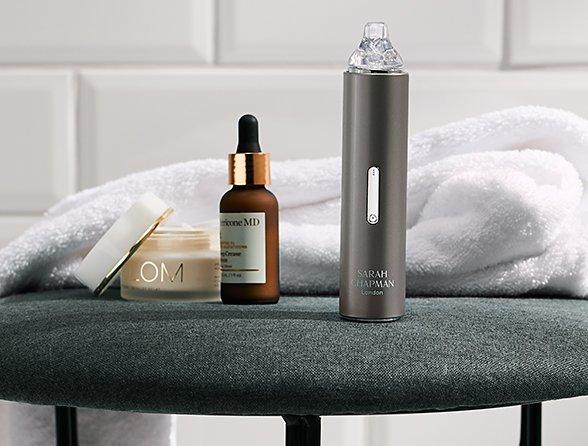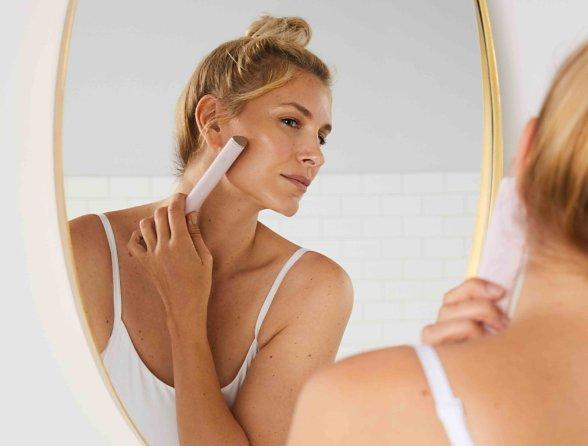4 easy changes that will bring you closer to flawless skin
Healthy, radiant and blemish-free skin is the holy grail of the beauty world, yet for many it continues to feel tantalisingly hard to achieve
So what’s the problem? You’re diligently cleansing, toning and moisturising, getting your allotted eight hours of sleep, eating your five a day and glugging the recommended eight glasses of water, and yet the numbers still aren’t quite adding up to a flawless complexion. Dr Anita Sturnham, a GP specialising in skin health and dermatology, gives her top skincare switches that will have you glowing in no time (spoiler alert: some may just surprise you).
It’s never too late to start some good skin habits and consistency is key, according to Dr Sturnham. ‘Through my extensive clinical experience, treating many different skin types and concerns, I have seen that it is only with repeated daily applications of targeted ingredients that the best results are achieved. Products that promise overnight transformations rarely deliver and it’s vital to be consistent with skincare because stability and routine are the bedrock of good skin health.’
Time to take things back to basics for a skin ‘reset’.
1. Cleanse clever
‘Rather than stripping your skin with over-zealous cleansing and exfoliating regimens that can leave it looking dull and dehydrated, adopt a cleansing approach that is much more protective of your skin’s barrier. In the morning use a cream or gel-based, non-foaming formulation and look for gentle ingredients such as wheatgerm or rosehip, combined with a natural humectant ingredient, such as glycerin. At night you can take things up a gear and use some gentle fruit acids. I recommend an AHA/BHA combination. Lactic acid is a brilliantly hydrating exfoliator that works to brighten the superficial layers and remove old, tired-looking skin cells, while salicylic acid is your deep pore cleanser that delves into your pores and unblocks them.’
2. Introduce a serum
‘The game changer when it comes to transforming my patient’s skin, is introducing an AM and PM serum strategy. It’s the one product in your regimen that is designed to treat the deeper skin layers and so is essential for radiant skin. In the morning, use a serum that is packed full of antioxidants, such as vitamins B, C, E, ferulic acid and niacinamide and avoid oil-based serums that can clog your pores (you can tell by looking for water/aqua in the top four ingredients on the INCI list). At night, your serum strategy should be focused on rebuilding and repair. Regardless of your age or skin concern, vitamin A is a great nutrient to introduce. Other skin heroes to look for are plant-based stem cells, for their rejuvenating properties, as well as barrier-restoring hyaluronic acid and squalane.’
3. Switch up your moisturiser
‘We often underestimate the power of moisturiser, but finding the right one for your skin can be transformative and, contrary to popular belief, even oily skin types need hydration as a lack of moisture can actually prompt the skin to over-produce oil to compensate. As a rule, I recommend owning two moisturisers – a light texture and a richer texture, which contain barrier-supporting ingredients such as botanical peptides and hyaluronic acid. Our skin’s needs change on a daily basis and, while most skin types prefer a lighter texture in the morning and a richer texture at night, you may have days where your skin feels drier or dehydrated due to stress, hormones, travel and so on, and a richer formulation may be preferable morning and night. It’s about being responsive to your skin's needs. Finding a moisturiser that works as a primer too means that you can skip this additional step as some primers can be pore-clogging.’
4. Clean up your act
Got your routine down, but still find you’re blighted by blemishes? You may want to consider some of the more surprising causes of breakouts. Acne develops when our pores become blocked with sebum, dirt and dead skin cells, which then provide the perfect breeding ground for inflammation-causing bacteria. While the tips above can help tackle the oil-balancing side of things, it’s time to make a clean start by identifying triggers that you may not automatically think of, such as mobile phones, masks, pillowcases and headgear like hats and hairbands – all of which can harbour blemish-causing bacteria. If it can’t be washed (we recommend cleaning makeup brushes and changing pillowcases every two to three days), simply wipe with an antibacterial gel or spritz with a spot-fighting skincare solution (a good idea for those experiencing ‘maskne’).
If you find that you’re getting spots around your hairline, neck and shoulders, your haircare could be to blame (conditioner in particular is a known culprit). Simply use a cotton pad soaked in a spot-clearing toner and sweep over affected areas twice a day, while making sure you cleanse away any residue of conditioner before getting out of the shower.




